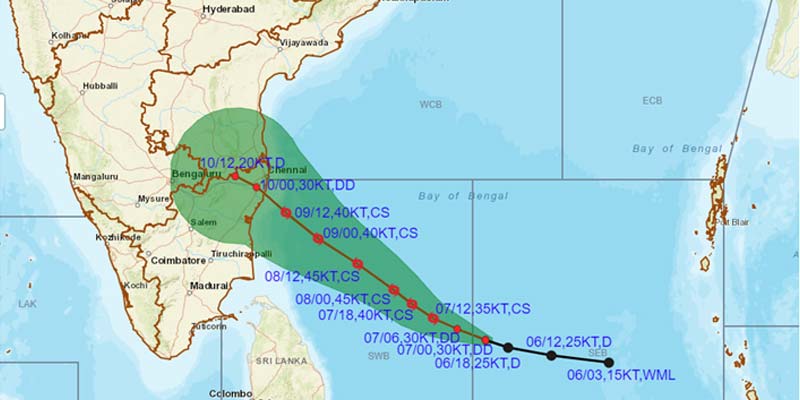- India
- Dec 07
What is the role of National Crisis Management Committee?
• The National Crisis Management Committee (NCMC), headed by Cabinet Secretary Rajiv Gauba, reviewed the preparedness for a possible cyclonic storm over the Bay of Bengal that may hit the eastern coast.
• The National Disaster Response Force (NDRF) has made five teams available for Tamil Nadu and three teams for Puducherry.
• The NCMC reviewed the preparedness of central ministries, agencies, and state and Union Territory governments for the possible cyclonic storm over the Bay of Bengal.
• Teams are also being kept on standby for Andhra Pradesh and they will be activated as and when the state government asks for them.
Management of natural disasters
• The ministry of home affairs is the nodal ministry for management of natural disasters (other than drought, hailstorm, pest attack and cold wave/frost, which are handled by the ministry of agriculture).
• The basic responsibility for undertaking relief, rehabilitation, preparedness, mitigation and response measures in the event of a disaster rests with the concerned state government.
• The central government supplements the efforts of the state governments by providing logistic and financial support in case of natural calamities of severe nature.
• The logistic support includes deployment of aircrafts and boats, specialist teams of Armed Forces, Central Paramilitary Forces and personnel of National Disaster Response Force (NDRF), arrangements for relief materials and essential commodities including medical stores, restoration of critical infrastructure facilities including communication network and such other assistance as may be required by the affected states to meet the situation effectively.
• Various committees involving all departments that are working in disaster management play key roles in coordination at the central and state level.
National Crisis Management Committee
• The NCMC has been constituted under the chairmanship of the Cabinet Secretary. The other members of this Committee include the secretary to the Prime Minister, secretaries of the ministries of home affairs, defence, agriculture and cooperation, RAW and director of Intelligence Bureau.
• The NCMC gives direction to the Crisis Management Group as deemed necessary.
Crisis Management Group (CMG)
• This is a group under the chairmanship of the Relief Commissioner comprising the senior officers from the various ministries and other concerned departments.
• The CMG will meet at least twice in a year in the months of December/January and May/June and as often as may be required by the Relief Commissioner in Krishi Bhavan, New Delhi.
Functions of CMG:
i) Reviews every year contingency plans formulated by the central ministries/departments.
ii) Reviews measures required for dealing with a natural calamity.
iii) Coordinates the activities of the central ministries and state governments in relation to disaster preparedness and relief.
iv) Obtains information from the nodal officers on measures relating to the above.
• The nodal officer of each ministry/department would be responsible for the formulation of a Detailed Action Plan (DAP) clearly laying down the channel and manner of interaction, between agencies engaged in these functions, details of the contact points, and the specific measures and time-frames for their implementation.
• The specific action plan of individual ministry/department shall be submitted to the Central Relief Commissioner. The CMG will review these action plans every year and get them updated from time to time.
NDMA Control Room
In order to render advice to the Centre on the disaster situation at all times, the National Disaster Management Authority needs to remain fully apprised on the latest updated information. For this critical activity, a Control Room is located at the NDMA Bhawan which is a repository for disaster specific information and data input facility.
The Control Room is manned 24x7 and has a National Helpline (1078). The Control Room shares critical disaster related inputs with the concerned states through video conferencing and other means and coordinates response activities.
Role of the state government
• Most of the states have Relief Commissioners under the department of disaster management, who are in charge of the relief measures in the wake of natural disasters. In the absence of the Relief Commissioner, the chief secretary or an officer nominated by him is in overall charge of the relief operations in the concerned state.
• The State Relief Commissioner supervises and controls relief operations through Collectors or Deputy Commissioners, who are the main functionaries to coordinate the relief operation at district level.
• The state governments are autonomous in organising relief operations in the event of natural disasters and in developing the long-term rehabilitation measures.
National Disaster Response Force
• The Disaster Management Act, 2005 included provisions for the constitution of the National Disaster Response Force (NDRF) for the purpose of specialised response to natural and man-made disasters.
• Accordingly, in 2006 NDRF was constituted with eight battalions. At present, NDRF has a strength of 16 battalions with each battalion consisting of 1,149 personnel.
• Earlier, the personnel of NDRF were deployed for routine law and order duties also. In 2007, during a meeting of the NDMA with the Prime Minister, the need of NDRF being made a dedicated force was highlighted and accepted. This led to the notification of NDRF Rules on February 14th , 2008, making NDRF a dedicated force for disaster response related duties, under the unified command of DG NDRF.
Manorama Yearbook app is now available on Google Play Store and iOS App Store

